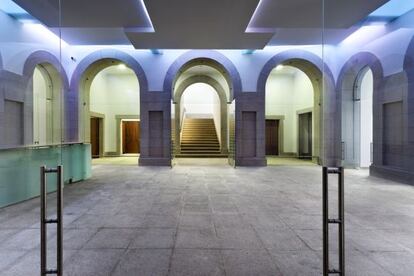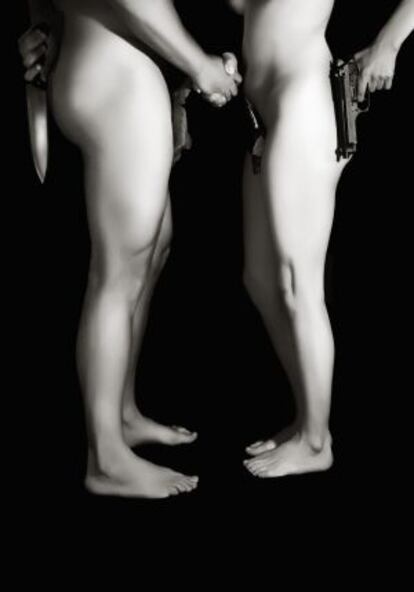Daring to shine amid the crisis
The Portuguese city of Évora opens a stunning new exhibition center


The latest attraction to the historic and beautifully conserved Portuguese city of Évora is the Fórum Eugénio de Almeida, located in the heart of this UNESCO World Heritage Site. The project has taken two years to complete at a cost of four million euros — 80 percent of it from European Union funds — and will be used for exhibitions, concerts, and conferences.
The 16th-century building, facing an elegant Roman colonnade, is huge, covering around 3,000 square meters and with some 20 rooms. A former palace belonging to the Holy Inquisition, it has been magnificently restored. The cells in its basement have been left intact, providing a ghoulish reminder of the original purpose of the building. Similarly, there is something unsettling still about the main hall, where the Catholic Church's hierarchy would judge those considered to have broken with religious doctrine.
The only other room that has been left as it originally would have been is the Grand Inquisitor's Chamber, which retains its fixtures, and looks out on to a garden. The rest of the vast building has been gutted. "We preferred to leave this as a place of meditation, of solitude, at the same as being a place of welcome," says Maria de Céu Ramos, the secretary general of the Eugénio de Almeida Foundation.
The Fórum Eugénio de Almeida is laid out on two levels of the three-story building and includes 1,200 square meters of temporary exhibition areas and two specialized areas. The Fórum also has an auditorium, multipurpose rooms, a meeting and conference center, leisure areas (restaurant, coffee shop and wine bar) and a shop. Outside there is a courtyard and two gardens.

The Foundation was created 50 years ago by Vasco Maria Eugénio de Almeida, who decided to give over part of the huge fortune his family had amassed over the years, largely by working the lands around Évora. The family continues to produce some of the finest wines in Portugal. In the mid-1960s, Eugéni de Almeida bought the palace formerly used by the Inquisition, which at that time was being used as a hotel. He wanted to turn it into the seat of the Foundation he had set up, but it was instead used as a university facility.
In 2008, when the university moved to new premises in the city, the Foundation decided to follow the wishes of De Almeida (who had died in 1975) and use the building as its headquarters. The inauguration was on July 11, which saw the opening of an exhibition called Open Doors, featuring the work of 450 artists.
"In honor of the title of the exhibition, we decided to call on artists from all over the world. Any artist, in any country, famous or unknown, was free to send us a proposal. They were asked to send us a digitalized copy of their piece, which could be anything: a painting, a photograph, or a sculpture," says Claudia Gianetti, the exhibition's curator. "We received 700 entries, and of those we chose 450. They are all reproduced in the same format, and organized thematically. Miraculously, they all work well together," she explains. The exhibition runs until October 9. After that, the center will organize regular events.
Walking round the palace, Gianetti points out a restored 16th-century fresco in a cloister. The renovation has been carried out with extreme care, using the most up-to-date methods, she says, and which has breathed new life into the building.
The Foundation is funded by its wine production, and does not depend on any state input. But given the gravity of the economic crisis that has hit Portugal over the last five years, many questioned the sanity of embarking on such as costly project in a site that is 150 kilometers from the capital, and 500 kilometers from Madrid. But Gianetti, who spends her time between Évora and Barcelona says: "The digital revolution means that there is no longer a center, nor a periphery, of the art world. And proof of this is that the exhibition we have organized features 450 artists of more than 50 nationalities." Maria de Céu Ramos admits there were dangers in pressing ahead with the project: "Obviously this was a risky venture, but there is no gain without taking risks, and this was worth it."
Tu suscripción se está usando en otro dispositivo
¿Quieres añadir otro usuario a tu suscripción?
Si continúas leyendo en este dispositivo, no se podrá leer en el otro.
FlechaTu suscripción se está usando en otro dispositivo y solo puedes acceder a EL PAÍS desde un dispositivo a la vez.
Si quieres compartir tu cuenta, cambia tu suscripción a la modalidad Premium, así podrás añadir otro usuario. Cada uno accederá con su propia cuenta de email, lo que os permitirá personalizar vuestra experiencia en EL PAÍS.
¿Tienes una suscripción de empresa? Accede aquí para contratar más cuentas.
En el caso de no saber quién está usando tu cuenta, te recomendamos cambiar tu contraseña aquí.
Si decides continuar compartiendo tu cuenta, este mensaje se mostrará en tu dispositivo y en el de la otra persona que está usando tu cuenta de forma indefinida, afectando a tu experiencia de lectura. Puedes consultar aquí los términos y condiciones de la suscripción digital.
Últimas noticias
The complicated life of Francesca Albanese: A rising figure in Italy but barred from every bank by Trump’s sanctions
From digital curfews to blocking apps: How technology experts protect their children online
Why the price of coffee has skyrocketed: from Brazilian plantations to specialty coffee houses
Confined to a Cuban hospital: When electricity is a matter of life or death
Most viewed
- Pablo Escobar’s hippos: A serious environmental problem, 40 years on
- Why we lost the habit of sleeping in two segments and how that changed our sense of time
- Trump’s obsession with putting his name on everything is unprecedented in the United States
- Charles Dubouloz, mountaineering star, retires at 36 with a farewell tour inspired by Walter Bonatti
- The Florida Keys tourist paradise is besieged by immigration agents: ‘We’ve never seen anything like this’








































